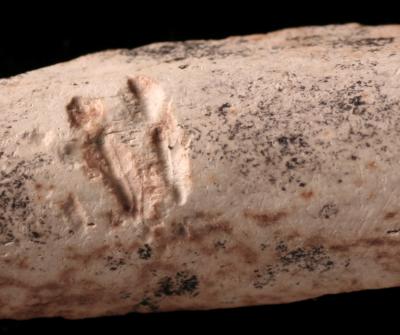New Haven, Conn. — Paleontologists have discovered the oldest mammalian tooth marks yet on the bones of ancient animals, including several large dinosaurs. They report their findings in a paper published online June 16 in the journal Paleontology.
About the image above: This is a close-up of the tooth marks gouged in the rib bone of a large dinosaur by a mammal that lived 75 million years ago. Image credit: Nicholas Longrich/Yale University.
The researchers believe the marks were made by mammals because they were created by opposing pairs of teeth—a trait seen only in mammals from that time.
They think they were most likely made by multituberculates, an extinct order of archaic mammals that resemble rodents and had paired upper and lower incisors. Several of the bones display multiple, overlapping bites made along the curve of the bone, revealing a pattern similar to the way people eat corn on the cob.
There are likely many other instances of mammalian tooth marks on other bones that have yet to be identified, including older examples, said Longrich. “The marks stood out for me because I remember seeing the gnaw marks on the antlers of a deer my father brought home when I was young,” he said. “So when I saw it in the fossils, it was something I paid attention to.”
But he points out that the Late Cretaceous creatures that chewed on these bones were not nearly as adept at gnawing as today’s rodents, which developed that ability long after dinosaurs went extinct.
*Source: EurekAlert

